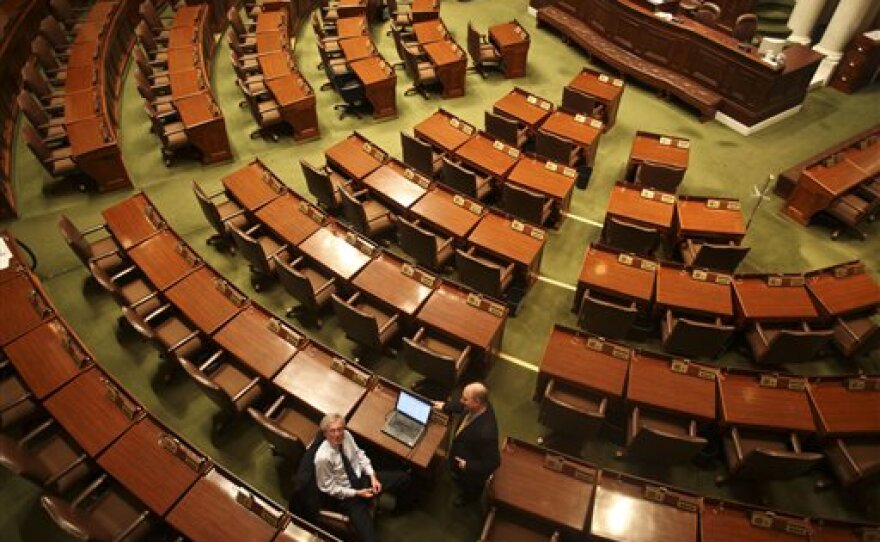In Minnesota Friday, highway construction came to a halt, rest stops and state parks closed. And 22,000 state workers have been laid off. The reason: a protracted budget dispute between the state's Democratic governor and Republicans who control the Legislature.
In the absence of talks between Democratic Gov. Mark Dayton and GOP legislative leaders, the shutdown was rippling into the lives of people like Sonya Mills, a 39-year-old mother of eight facing the loss of about $3,600 a month in state child care subsidies.
Until the government closure, Mills had been focused on recovering from a May 22 tornado that displaced her from a rented home in Minneapolis. Now she's adding a new problem to her list.
"It just starts to have a snowball effect. It's like you are still in the wind of the tornado," said Mills, who works at a temp agency and was allowed to take time off as she gets back on her feet. But after the shutdown, she also has to care for her six youngest children, ages 3 through 14, because she lost state funding for their day-care and other programs.
Clash Over Budget, And Taxes
Minnesota is the only state to have its government shut down this year, even though nearly all states have severe budget problems and some have divided governments. Dayton was determined to raise taxes on the top earners to help erase a $5 billion deficit, while the Republican Legislature refused to go along with that — or any new spending above the amount the state is projected to collect.
Here, as in 21 other states, there's no way to keep government operating past the end of a budget period without legislative action. Even so, only four other states — Michigan, New Jersey, Pennsylvania and Tennessee — have had shutdowns in the past decade, some lasting mere hours.
The shutdown halted non-emergency road construction and closed the state zoo and Capitol. More than 40 state boards and agencies went dark, though critical functions such as state troopers, prison guards, the courts and disaster responses will continue.
Revenue department worker Jenny Foster says she had given up hope there would be an agreement.
"They're just sitting there playing their games for show," she says. "I know what they're doing isn't for real. It's for show — to say that they're working. But they're not."
The financial impact of the closure is still uncertain. The state will save some money by not paying workers. But if the shutdown drags on, Minnesota taxpayers could be on the hook for millions in unemployment payments to public employees, as well as missed park fees and delays in construction projects.
A Tight Dispute On Party Lines
As frustration among Minnesota residents grew, there was no word Friday of any plans to continue budget negotiations. Instead, the heads of the state's Republican and Democratic parties blasted each other for Minnesota's second shutdown in six years.
GOP Chairman Tony Sutton called Dayton a "piece of work" and accused him of inflicting "maximum pain" for political reasons.
Democratic Farmer Labor Party Chairman Ken Martin laid the blame on Republicans, saying they drove the state to a shutdown to protect millionaires from tax increases sought by Dayton.

Dayton wants to raise income taxes on top earners to help close a $5 billion budget gap. Republicans, in charge of both the House and Senate for the first time in 40 years, say that's out of the question.
The GOP offered a last-minute stopgap funding bill, but the governor rejected it. And Senate Majority Leader Amy Koch placed the blame for the shutdown squarely on him.
"This shutdown is not necessary," she said. "And once again, we've proved that by laying on the governor's desk a temporary funding bill keeping government going for the next 10 days, while we finish these negotiations."
But Dayton said the "lights on" bill was just a publicity stunt, and that Republicans had plenty of time to help close the divide on taxes and spending.
"Anybody who wanted to avoid a shutdown today knew that there was one way to do it, and that was to accept a budget proposal that would bridge this gap," he said. "And the Republican caucuses rejected our offers to do so."
Service Groups Seek Help, And Alternatives
With the executive and legislative branches of Minnesota government at loggerheads, power has shifted to the courts for now. A judge has ruled that prisons, the state police, nursing homes, Medicaid, and other critical services must continue operating.
There will be more decisions soon, as nonprofit social service agencies that didn't make the cut petition the court for emergency funding.
Minnesota food pantries were scurrying to make sure they would still get 700,000 pounds of food — about 30 percent of their total volume — in the next two months through a federal program. Nearly 1 million pounds already in warehouses can't be delivered during the shutdown.
Colleen Moriarty, executive director of Hunger Solutions Minnesota, said the federal program's operation depends on a single state employee working in a data management system. She will ask a court-appointed referee next Tuesday to deem the worker essential.
Byron Laher, director of a program that runs food shelves in three northern Twin Cities suburbs, said the federal donations help those pantries feed 1,300 families each month.
"We're not in position to go out and buy food to replace that," Laher said.
With reporting by Matt Sepic of Minnesota Public Radio. This article also contains material from The Associated Press.
Copyright 2022 NPR. To see more, visit https://www.npr.org. 9(MDAzMjM2NDYzMDEyMzc1Njk5NjAxNzY3OQ001))






